Résultats de recherche de titre
Articles 1489981 à 1490000 sur 1503312
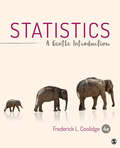
Statistics: A Gentle Introduction
Par Frederick L. Coolidge. 2021
The Fourth Edition of Statistics: A Gentle Introduction shows students that an introductory statistics class doesn’t need to be difficult…
or dull. This text minimizes students’ anxieties about math by explaining the concepts of statistics in plain language first, before addressing the math. Each formula within the text has a step-by-step example to demonstrate the calculation so students can follow along. Only those formulas that are important for final calculations are included in the text so students can focus on the concepts, not the numbers. A wealth of real-world examples and applications gives a context for statistics in the real world and how it helps us solve problems and make informed choices. New to the Fourth Edition are sections on working with big data, new coverage of alternative non-parametric tests, beta coefficients, and the "nocebo effect," discussions of p values in the context of research, an expanded discussion of confidence intervals, and more exercises and homework options under the new feature "Test Yourself." Included with this title: The password-protected Instructor Resource Site (formally known as SAGE Edge) offers access to all text-specific resources, including a test bank and editable, chapter-specific PowerPoint® slides.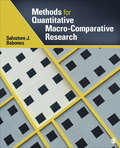
Methods for Quantitative Macro-Comparative Research
Par Salvatore J. Babones. 2014
Will a one-child policy increase economic growth? Does globalization contribute to global warming? Are unequal societies less healthy than more…
egalitarian societies? It is questions like these that social scientists turn to quantitative macro-comparative research (QMCR) to answer. Although many social scientists understand statistics conceptually, they struggle with the mathematical skills required to conduct QMCR. This non-mathematical book is intended to bridge that gap, interpreting the advanced statistics used in QMCR in terms of verbal descriptions that any college graduate with a basic background in statistics can follow. It addresses both the philosophical foundations and day-to-day practice of QMCR in an effort to improve research outcomes and ensure policy relevance. A comprehensive guide to QMCR, the book presents an overview of the questions that can be answered using QMCR, details the steps of the research process, and concludes with important guidelines and best practices for conducting QMCR. The book assumes that the reader has a sound grasp of the fundamentals of linear regression modeling, but no advanced mathematical knowledge is required in order for researchers and students to read, understand, and enjoy the book. A conversational discussion style supplemented by 75 tables and figures makes the book′s methodological arguments accessible to both students and professionals. Extensive citations refer readers back to primary discussions in the literature, and a comprehensive index provides easy access to coverage of specific techniques.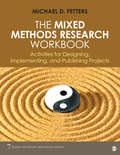
Written by Michael D. Fetters, one of the leading scholars in the field and co-editor of the Journal of Mixed Methods…
Research, The Mixed Methods Research Workbook: Activities for Designing, Implementing, and Publishing Projects is the perfect tool for doctoral students and researchers who want support throughout their research project, as well as a practical way to apply the knowledge they’ve learned. With The Mixed Methods Research Workbook, you’ll be ready to tackle your mixed methods research project with confidence. Each chapter follows a familiar framework, starting with learning objectives for each piece of the mixed methods process. Readers have ample space in this text to write notes, fill out activities, and begin their process of actively designing and writing up a mixed methods study. This easy-to follow process gives readers an immediate structure to their projects. Exemplar boxes provide a starting framework, with the text encouraging deeper reflection on mixed methods challenges and opportunities. Stories from the field illuminate struggles and suggestions with the benefit of hindsight. Checklists at the end of each chapter help readers stay organized and key resources provide up-to-date lists of material for further study. From start to finish, readers can follow along with this text as they work on their projects. The text begins by assisting readers in identifying topics and conducting literature reviews in the context of mixed methods, zeroing in to address mixed-methods-specific challenges like integration, leveraging advantages of both qualitative and quantitative methods, and incorporating theory and personal backgrounds. Identifying data sources helps readers organize their data collection. Two chapters on research designs structure the data collection process with procedural diagrams. A unique chapter on mixed methods sampling offers application through basic and advanced designs. The book illustrates integrating and implementing mixed methods designs with practical advice for each of stage of the process. Ethics in a mixed methods context readies readers for the research protocol stage. Several chapters fully explicate the data analysis process, including developing a joint display, a state-of-the-art procedure for analysis and presentation of findings. Closing out the process, the text tackles quality and evaluation in mixed methods studies, preparing your study for publication, and writing up your article.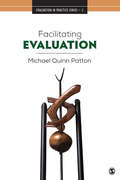
Facilitating Evaluation: Principles in Practice (Evaluation in Practice Series #2)
Par Michael Quinn Patton. 2018
Michael Quinn Patton’s Facilitating Evaluation: Principles in Practice is the first book of its kind to explain in depth and…
detail how to facilitate evaluation processes with stakeholders. Using the author’s own stories of his experiences as an evaluation facilitator, the book illustrates the five evaluation facilitation principles that are the organizing framework for addressing how to work with stakeholders to generate evaluation questions, make decisions among methods, interpret findings, and participate in all aspects of evaluation. Ultimately, this book will help readers perform facilitation to enhance the relevance, credibility, meaningfulness, and utility of evaluations. "A must-read for anyone considering a high-impact evaluation!" –Margaret Lombe, Boston College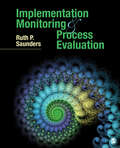
Implementation Monitoring and Process Evaluation
Par Ruth P. Saunders. 2016
This practical guide helps readers understand and use the steps that program planners and evaluators take in implementing and monitoring…
a new program, policy, or practice in an organizational setting. The book covers the entire process, from planning, to carrying out the plan, and summarizing, reporting, and using the results. A wide range of real-world examples in the book are drawn from health, education, non-profit organizations, and public administration, and an extended case study, Your Turn boxes, and worksheet templates help readers apply concepts to their own projects. Ideal for practitioners, researchers, and students, this book can be used as a primary text for a process evaluation or an implementation monitoring course or as a supplemental text in a broader program evaluation course.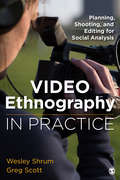
Video Ethnography in Practice: Planning, Shooting, and Editing for Social Analysis
Par Wesley M. Shrum, Gregory S. Scott. 2017
Video Ethnography in Practice is a brief guide for students in the social disciplines who are required to produce an…
ethnographic video, the most significant new methodological technique in 21st century social analysis. The authors, both accomplished videographers, cover the basic techniques of creating a video that documents human culture and behavior with true stories of the process of videography throughout. This text shows how new technologies like smart phones, widely available video editing software, and YouTube, have turned video ethnography into something that is within reach of students in a conventional course framework.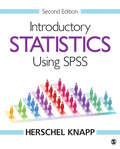
Introductory Statistics Using SPSS
Par Herschel Knapp. 2017
The updated Second Edition of Herschel Knapp’s friendly and practical introduction to statistics shows students how to properly select, process,…
and interpret statistics without heavy emphasis on theory, formula derivations, or abstract mathematical concepts. Each chapter is structured to answer questions that students most want answered: What statistical test should I use for this situation? How do I set up the data? How do I run the test? How do I interpret and document the results? Online tutorial videos, examples, screenshots, and intuitive illustrations help students "get the story" from their data as they learn by doing, completing practice exercises at the end of each chapter using prepared downloadable data sets.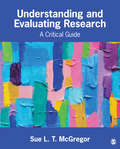
Understanding and Evaluating Research: A Critical Guide
Par Sue L. McGregor. 2018
Understanding and Evaluating Research: A Critical Guide shows students how to be critical consumers of research and to appreciate the…
power of methodology as it shapes the research question, the use of theory in the study, the methods used, and how the outcomes are reported. The book starts with what it means to be a critical and uncritical reader of research, followed by a detailed chapter on methodology, and then proceeds to a discussion of each component of a research article as it is informed by the methodology. The book encourages readers to select an article from their discipline, learning along the way how to assess each component of the article and come to a judgment of its rigor or quality as a scholarly report.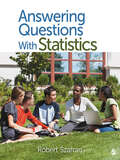
Answering Questions With Statistics
Par Robert F. Szafran. 2012
Finally, an introductory statistics text that provides broad coverage, limited theory, clear explanations, plenty of practice opportunities, and examples that…
engage today′s students!Using General Social Survey data from 1980 and 2010, this textbook asks students to consider how young adults have changed over the last 30 years. Students learn to select an appropriate data analysis technique, carry out the analysis, and draw conclusions.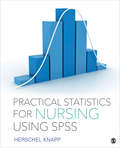
A friendly and approachable guide to real-world statistics, Practical Statistics for Nursing Using SPSS® covers the most common statistical functions…
in nursing science using plain language. Students learn by doing, and an emphasis on this practical approach is seen throughout the book with each chapter structured to answer key questions: What statistical test should I use for this situation? How do I set up the data? How do I run the test? How do I interpret and document the results? Practice exercises include a vignette, codebook, and data sets ready for processing, enabling students to achieve mastery by carrying out actual statistical analyses. Online resources for students are available and include data sets for examples and exercises, fully developed solutions to all odd-numbered exercises, and thorough tutorial videos providing an overview of each statistical method, step-by-step guidance on SPSS® processing, and interpretation of results. Online resources for instructors include Microsoft® PowerPoint® slides for each chapter and solutions to all exercises.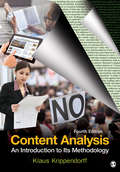
Content Analysis: An Introduction to Its Methodology
Par Klaus Krippendorff. 2019
What matters in people’s social lives? What motivates and inspires our society? How do we enact what we know? Since…
the first edition published in 1980, Content Analysis has helped shape and define the field. In the highly anticipated Fourth Edition, award-winning scholar and author Klaus Krippendorff introduces readers to the most current method of analyzing the textual fabric of contemporary society. Students and scholars will learn to treat data not as physical events but as communications that are created and disseminated to be seen, read, interpreted, enacted, and reflected upon according to the meanings they have for their recipients. Interpreting communications as texts in the contexts of their social uses distinguishes content analysis from other empirical methods of inquiry. Organized into three parts, Content Analysis first examines the conceptual aspects of content analysis, then discusses components such as unitizing and sampling, and concludes by showing readers how to trace the analytical paths and apply evaluative techniques. The Fourth Edition has been completely revised to offer readers the most current techniques and research on content analysis, including new information on reliability and social media. Readers will also gain practical advice and experience for teaching academic and commercial researchers how to conduct content analysis.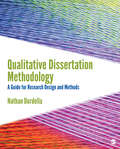
Qualitative Dissertation Methodology: A Guide for Research Design and Methods
Par Nathan Richard Durdella. 2019
Designing and writing a qualitative dissertation methodology chapter can be done! Qualitative Dissertation Methodology: A Guide for Research Design and…
Methods functions as a dissertation advisor to help students construct and write a qualitative methodological framework for their research. Drawing from the challenges author Nathan Durdella has experienced while supervising students, the book breaks down producing the dissertation chapter into smaller pieces and goes through each portion of the methodology process step by step. With a warm and supportive tone, he walks students through the process from the very start, from choosing chairs and developing qualitative support networks to outlining the qualitative chapter and delving into the writing. By the end of the book, students will have completed the most challenging chapter of a qualitative dissertation and laid a strong foundation for the rest of their dissertation work. Corresponding videos featuring the author help concepts come alive for your students.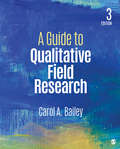
A Guide to Qualitative Field Research
Par Carol R. Bailey. 2018
A Guide to Qualitative Field Research provides readers with clear, practical, and specific instructions for conducting qualitative research in the…
field. In the expanded Third Edition, Carol A. Bailey gives increased attention to the early and last stages of field research, often the most difficult: selecting a topic, deciding upon the purpose of your research, and writing the final paper, all in her signature reader-friendly writing style. This edition features research examples from graduate and undergraduate students to make examples meaningful to fellow students; a new "Putting It All Together" feature, with examples of how different parts of the research process interact; and more emphasis on the "nuts and bolts" of research, such as what to include in an informed consent form, a proposal, and the final paper.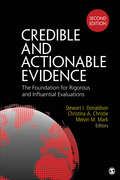
Credible and Actionable Evidence: The Foundation for Rigorous and Influential Evaluations
Par Stewart I. Donaldson, Melvin M. Mark, Christina A. Christie. 2015
Addressing one of the most important and contentious issues challenging applied research and evaluation practice today—what constitutes credible and actionable…
evidence?—this volume offers a balanced and current context in which to analyze the long-debated quantitative-qualitative paradigms. In the Second Edition, the contributors, a veritable "who’s who" in evaluation, discuss the diversity and changing nature of credible and actionable evidence; offer authoritative guidance about using credible and actionable evidence; explain how to use it to provide rigorous and influential evaluations; and include lessons from their own applied research and evaluation to suggest ways to address the key issues and challenges. Reflecting the latest developments in the field and covering both experimental and non-experimental methods, the new edition includes revised and updated chapters, summaries of strengths and weaknesses across varied approaches, and contains diverse definitions of evidence. Also included are two new chapters on assessing credibility and synthesizing evidence for policy makers. This is a valuable resource for students and others interested in how to best study and evaluate programs, policies, organizations, and other initiatives designed to improve aspects of the human condition and societal well-being.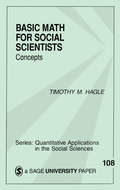
Basic Math for Social Scientists: Concepts (Quantitative Applications in the Social Sciences #108)
Par Timothy M. Hagle. 1995
Taking an informal approach, Hagle presents a review of the basic mathematical concepts that underlie most quantitative analysis in the…
social sciences. After an algebra review featuring sets and combinations, Hagle discusses limits and continuity. Calculus is presented next, with an introduction to differential calculus. Multivariate functions, partial derivatives and integral calculus are discussed; the author concludes with a discussion of matrix algebra. Aimed at readers who have taken one or two courses in algebra, this volume is packed with helpful definitions, equations, and examples as well as alternative notations. A useful appendix of common math symbol and Greek letters is also included.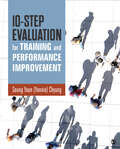
10-Step Evaluation for Training and Performance Improvement
Par Seung Youn Chyung. 2019
Written with a learning-by-doing approach in mind, 10-Step Evaluation for Training and Performance Improvement gives students actionable instruction for identifying,…
planning, and implementing a client-based program evaluation. The book introduces readers to multiple evaluation frameworks and uses problem-based learning to guide them through a 10-step evaluation process. As students read the chapters, they produce specific deliverables that culminate in a completed evaluation project.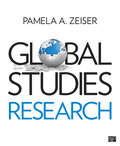
Global Studies Research
Par Pamela A. Zeiser. 2020
Global Studies Research is a research methods textbook designed for interdisciplinary International Studies majors and their faculty. The textbook introduces interdisciplinarity,…
provides basic building blocks of relevant disciplinary knowledge, explains a process for integrating knowledge from multiple disciplines, and models this interdisciplinary International Studies Research Process in its presentation of the case studies.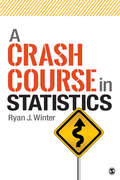
A Crash Course in Statistics
Par Ryan J. Winter. 2018
A Crash Course in Statistics is a short introduction to key statistical methods including descriptive statistics, one-way and two-way ANOVA,…
the t-test, and Chi Square. Each of the five chapters provides an overview of each method, and then walks readers through a relevant example, using SPSS to highlight how to run the statistics and how to write up the results in APA style. Each chapter ends with a self-quiz so that readers can assess their understanding of each statistical concept. This "crash course" supplement is a must-have statistics refresher for students taking research methods classes; a handy additional reference for introductory statistics students; and a guide for anyone who needs to be a consumer of statistics.
Introductory Statistics Using SPSS
Par Herschel Knapp. 2017
The updated Second Edition of Herschel Knapp’s friendly and practical introduction to statistics shows students how to properly select, process,…
and interpret statistics without heavy emphasis on theory, formula derivations, or abstract mathematical concepts. Each chapter is structured to answer questions that students most want answered: What statistical test should I use for this situation? How do I set up the data? How do I run the test? How do I interpret and document the results? Online tutorial videos, examples, screenshots, and intuitive illustrations help students "get the story" from their data as they learn by doing, completing practice exercises at the end of each chapter using prepared downloadable data sets.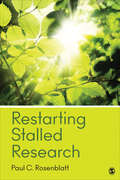
Restarting Stalled Research
Par Paul C. Rosenblatt. 2016
Written for researchers and graduate students writing dissertations, this unique book offers detailed advice and perspective on many issues that…
can stall a research project and reveals what can be done to successfully resume it. Using a direct yet conversational style, author Paul C. Rosenblatt draws on his decades of experience to cover many diverse topics. The text guides readers through challenges such as clarifying the end goal of a project; resolving common and not-so-common writing problems; dealing with rejection and revision decisions; handling difficulties involving dissertation advisers and committee members; coping with issues of researcher motivation or self-esteem; and much more.